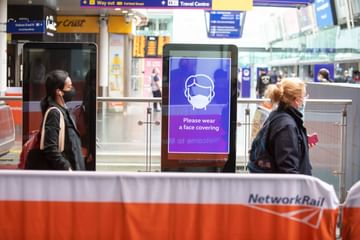 by David Portman
by David PortmanKeeping on track: How Network Rail has documented the COVID-19 pandemic
David Portman reports on how Network Rail, a critical national service, enabling vital passenger train services for key workers, whilst also increasing freight traffic to get medical supplies, food and other goods around Britain are managing record keeping during the COVID-19 Pandemic.
Thank you to Business In The News for its article exploring how Network Rail are managing record keeping during the COVID-19 Pandemic last week.
Network Rail owns and operates Britain’s railway infrastructure from tracks and signalling to stations, tunnels and bridges. During the COVID-19 pandemic they have been responsible for keeping Britain’s railway running. It has been the job of Network Rail’s archivist, Vicky Stretch and her team to document their response to the pandemic for historical, cultural and legal reasons alike.
Network Rail is a critical national service, enabling vital passenger train services for key workers, whilst also increasing freight traffic to get medical supplies, food and other goods around Britain throughout a prolonged coronavirus outbreak. From a governance and corporate responsibility level, keeping records relating to this activity is essential.
Network Rail is also mandated to keep records under the Railway Heritage Act; in Britain the railway industry is unique in that it has a specific Act of Parliament that requires it to keep records for historical purposes. So aside from the usual governance and accountability aspects of record keeping, the Network Rail COVID-19 archive will also demonstrate how the business coped with delivering a much-planned-for scenario, how the ‘railway family’ came together to deliver critical services to the country, and how the business and colleagues supported each other.
The shape of the railway industry has changed radically since the start of the pandemic. Key to this was Network Rail’s planning and publication of new emergency railway timetables. This had to be introduced in response to falling passenger demand, as people changed their travel patterns to help tackle the spread of Coronavirus, as well as the need to dramatically increase freight movement.
Capturing these new timetables as they are published, as well as the planning documentation behind them is key to Network Rail’s COVID-19 archive collecting. It would usually take around 14 weeks to process a major timetable change such as this, but in these unprecedented times the Capacity Planning team turned it around in just one week.

As a business, Network Rail’s own ways of working have changed radically too. Signaling and maintenance teams have kept the railway safe and open for business, while back office functions have almost wholesale moved from office to home working. Capturing the contingency planning and operational documentation related to this shift has also been vital.
The COVID-19 content Network Rail is producing is almost entirely digital. Vicky and her team are capturing policy, working instructions and guidance issued to the business as a whole to keep the workforce safe, as well as more ephemeral content such as all company messages, company magazines, information posters and press releases. These files are produced entirely digitally and distributed electronically to be printed on site if needed. This digital dissemination means items for the archive can be collected and ingested into Preservica by the archive in real time.
Information previously only accessible from corporate offices, needed to be accessed by staff based at home. The business had already been moving towards SharePoint Online and Office 365 and this was only accelerated in the new circumstances. This has meant the archive team quickly looking at how they can save SharePoint sites and libraries into Preservica on a much larger and automated scale, to be ready once the contingency planning and emergency operational requirements are scaled down and those records are able to be transferred.
The archive team’s own transition to remote working was made easier by Preservica. Since the solution is cloud-hosted and includes many features ‘out-of-the-box’, remote access has not been a problem. From home, the archive team have been able to ingest records into Preservica as they are published as well as set up more frequent web crawls of Network Rail’s websites to capture press releases and public facing communication.
The past few months have highlighted the importance of the archive keeping in step with the organisation; staying in touch with record creators and IT contacts as well as keeping up to date with how records are being created and how they are being stored and shared. Colleagues across Network Rail’s business are now much more actively involved in sharing material with the archive to be preserved, rather than a more traditional approach of relying on record retention schedules that mandate the handover of records after a period of time. Dynamic, proactive collecting in real time is now at the heart of the Network Rail archive – history is no longer something that is relegated to the past, it’s happening now and needs to be documented today.
